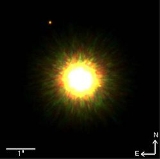
1RXS J160929.1-210524
Encyclopedia
1RXS J160929.1-210524 is a pre–main sequence star nearly 470 light-year
s away in the constellation
of Scorpius. The star
was identified as a year-old member of the Upper Scorpius
subgroup of the Scorpius-Centaurus Association
by Thomas Preibisch and coauthors in 1998.
to take pictures of the star which appeared to show a planet
(designated 1RXS J160929.1-210524 b). The apparent planet is very large—about eight times the mass of Jupiter
, orbiting the star at a distance of (roughly or miles). The orbital status of the companion planet was confirmed in a paper submitted on 2010 to The Astrophysical Journal. This makes it the smallest known exoplanet orbiting its host at such a distance. It is also the first announced directly imaged exoplanet orbiting a sun-like star, and the 2nd directly imaged exoplanet to have spectrum taken (after 2M1207b).
The discoverers note that the object's location far from its star presents serious challenges to current models of planetary formation: the timescale to form a planet by core accretion at this distance from the star would be longer than the age of the system itself. One possibility is that the planet may have formed closer to the star and migrated outwards as a result of interactions with the disk or with other planets in the system. An alternative is that the planet formed in situ via the disk instability mechanism, where the disk fragments because of gravitational instability, though this would require an unusually massive protoplanetary disk.
Light-year
A light-year, also light year or lightyear is a unit of length, equal to just under 10 trillion kilometres...
s away in the constellation
Constellation
In modern astronomy, a constellation is an internationally defined area of the celestial sphere. These areas are grouped around asterisms, patterns formed by prominent stars within apparent proximity to one another on Earth's night sky....
of Scorpius. The star
Star
A star is a massive, luminous sphere of plasma held together by gravity. At the end of its lifetime, a star can also contain a proportion of degenerate matter. The nearest star to Earth is the Sun, which is the source of most of the energy on Earth...
was identified as a year-old member of the Upper Scorpius
Scorpius
Scorpius, sometimes known as Scorpio, is one of the constellations of the zodiac. Its name is Latin for scorpion, and its symbol is . It lies between Libra to the west and Sagittarius to the east...
subgroup of the Scorpius-Centaurus Association
Scorpius-Centaurus Association
The Scorpius-Centaurus Association is the nearestOB Association to the Sun. This stellar association is composed of three subgroups The Scorpius-Centaurus Association (sometimes called Sco-Cen or Sco OB2) is the nearestOB Association to the Sun. This stellar association is composed of three...
by Thomas Preibisch and coauthors in 1998.
Planetary system
On 8 September 2008, it was announced that astronomer David Lafrenière and collaborators used the Gemini ObservatoryGemini Observatory
The Gemini Observatory is an astronomical observatory consisting of two telescopes at sites in Hawai‘i and Chile. Together, the twin Gemini telescopes provide almost complete coverage of both the northern and southern skies...
to take pictures of the star which appeared to show a planet
Planet
A planet is a celestial body orbiting a star or stellar remnant that is massive enough to be rounded by its own gravity, is not massive enough to cause thermonuclear fusion, and has cleared its neighbouring region of planetesimals.The term planet is ancient, with ties to history, science,...
(designated 1RXS J160929.1-210524 b). The apparent planet is very large—about eight times the mass of Jupiter
Jupiter
Jupiter is the fifth planet from the Sun and the largest planet within the Solar System. It is a gas giant with mass one-thousandth that of the Sun but is two and a half times the mass of all the other planets in our Solar System combined. Jupiter is classified as a gas giant along with Saturn,...
, orbiting the star at a distance of (roughly or miles). The orbital status of the companion planet was confirmed in a paper submitted on 2010 to The Astrophysical Journal. This makes it the smallest known exoplanet orbiting its host at such a distance. It is also the first announced directly imaged exoplanet orbiting a sun-like star, and the 2nd directly imaged exoplanet to have spectrum taken (after 2M1207b).
The discoverers note that the object's location far from its star presents serious challenges to current models of planetary formation: the timescale to form a planet by core accretion at this distance from the star would be longer than the age of the system itself. One possibility is that the planet may have formed closer to the star and migrated outwards as a result of interactions with the disk or with other planets in the system. An alternative is that the planet formed in situ via the disk instability mechanism, where the disk fragments because of gravitational instability, though this would require an unusually massive protoplanetary disk.
External links
- Astronomy Picture of the DayAstronomy Picture of the DayAstronomy Picture of the Day is a website provided by NASA and Michigan Technological University . According to the website, "Each day a different image or photograph of our universe is featured, along with a brief explanation written by a professional astronomer."The photograph is not necessarily...
- Companion of a Young, Sun-like Star Confirmed - 2010 July 4

